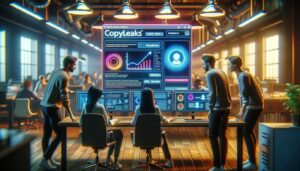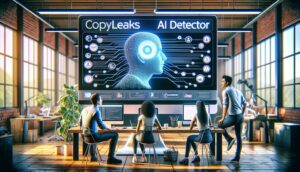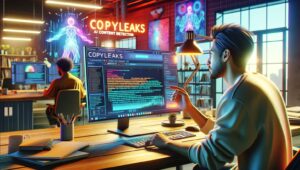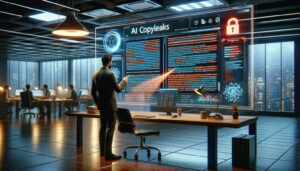How accurate is Copyleaks? Does it live up to the hype? We’ve got the answers to your questions so read on.
Are you scratching your head, trying to figure out if that essay or article you just read is penned by a human or crafted by some cheeky AI? You’re not alone.
It’s as if we’re all playing this giant game of ‘Guess Who?’ except instead of guessing between people with hats and glasses, we’re sorting out what’s real from what’s robot talk.

Try these new AI-powered tools:
- 5 Best AI Detectors To Unmask AI-Written Content With Accuracy
- 5 Best AI Writers To Boost Your Productivity And Content Quality.
- This "Secret AI Writer" Can Bypass AI Detection Like A Pro.
Enter Copyleaks—a tool that promises to be your Sherlock Holmes in the mysterious world of AI-generated text.
Now, did you know Copyleaks claims to have a magnifying glass powerful enough to spot those sneaky bots lurking behind paragraphs? Yup! But how good is it really at playing detective? That’s the million-dollar question.
In this bloggy adventure, we’ll unravel the enigma wrapped up in code – leading you through studies, reviews, and some eyebrow-raising facts about accuracy that might make even Mr. Holmes do a double-take.
Stick around—there’s more than meets the eye (or scanner)!
Article At-A-Glance
- Copyleaks is a tool that checks if text is written by humans or AI and it’s generally good at spotting the difference. But sometimes, it makes mistakes like thinking real writing is AI (false positives) or missing copied stuff (false negatives).
- Studies tested Copyleaks’ ability to find AI-written text and while it wasn’t perfect, it did better than some other tools out there. Sometimes creative writing can trick these tools into making errors.
- People use Copyleaks in schools and businesses to make sure work is original, but if Copyleaks messes up, it could hurt reputations or even lead to legal problems from copyright issues.
- Good reviews say Copyleaks catches copied content well. However, detecting sneaky AI-written content can be tougher for it – accuracy varies depending on how tricky the text is.
- Compared to similar tools, Copyleaks scores high in detection accuracy and has an extensive database plus support for multiple languages. It’s also user-friendly and priced competitively.
Table Of Contents
How Accurate Is Copyleaks? Third-Party Studies
Ever found yourself side-eyeing Copyleaks and wondering if it’s really the Sherlock Holmes of text detection, or just another wannabe Watson?
Well, read on, because third-party studies have put this AI detective under the microscope to answer that burning question: how accurate is Copyleaks?
Study: Detecting AI Content In Responses Generated By ChatGPT, YouChat, And Chatsonic
Let’s take a look at this study that found AI content from ChatGPT, YouChat, and Chatsonic. It’s kind of like a detective story but for words made by machines.
- Researchers wanted to see if they could tell when a computer wrote something.
- They used big brains (algorithms) to sniff out the AI-written stuff.
- First up was ChatGPT—it’s super smart and writes like a person.
- YouChat also got the magnifying glass treatment since it chats back and forth.
- Then there was Chatsonic—just like the others, spinning out text at a click.
- The big test? Feed these AI writings into Copyleaks to see if it would go “Aha! Gotcha!”
- These AIs are crafty—they try to blend in with human writing.
- But Copyleaks took on the challenge.
- Talk about suspense! The researchers waited to see what Copyleaks could do.
- Success! Copyleaks did pretty well at tagging those sneaky AI responses.
- Sometimes it missed—a few clever bot words slipped through the cracks.
- Let’s not forget that nothing’s perfect. There were some hiccups along the way.
Study: How Hard Can It Be? Testing The Reliability Of AI Detection Tools
Studying AI detection tools isn’t just smart, it’s crucial. That’s what the people behind “How Hard Can It Be? Testing the Reliability of AI Detection Tools” thought.
- Researchers really wanted to know how well these tools spot AI-written stuff.
- They put a bunch of tools to the test, including Copyleaks.
- Each tool was fed a mix of human and AI-penned pieces.
- The goal? See how often they could tell who wrote what.
- Some tools were pretty good at this game.
- Others …. not so much.
- Turns out, Copyleaks was one of the top performers!
- It did a great job finding content that wasn’t from humans.
- But keep in mind that no tool is perfect — even Copyleaks made some mistakes.
- In this study, they also checked how different writing styles affected detection.
- They found that sometimes super creative writing could trick the tools. Sneaky!
- Folks who ran the study think these tools need to keep getting better.
- Why? Because people are always coming up with new ways to create content. It’s kind of like a game of cat and mouse!
- Using AI detection is really important for keeping things honest and original online.
Study: The Effectiveness Of Software Designed To Detect AI-Generated Writing
Let’s talk about this one study, okay? It really delves into whether programs like Copyleaks can spot writing done by computers.
- The study took a hard look at how well different programs can tell if words were made by AI.
- Researchers chose a bunch of computer-written pieces for the test.
- They had these programs check the pieces to see which ones were made by a computer.
- Guess what – no program was perfect, but some did way better than others.
- For sure, Copyleaks was part of this mix. People really wanted to know how it stacked up.
- They found out that sometimes Copyleaks would get it right. Other times, not so much.
- This wasn’t just about guessing. The study was super careful to be fair.
- So, they used all sorts of different texts. Long ones, short ones – even stuff that looked like homework!
- Then they had humans look too, just to be sure.
- Turns out, tricky writing can fool these programs sometimes – including Copyleaks.
- But don’t worry! You’re not alone if you think this sounds pretty important.
Copyleaks: The Most Accurate AI-Generated Text Detector
Ready to go right into the world of AI content detection? Well, we’re about to explore just how Copyleaks stacks up in the accuracy department.
Think of it as your digital Sherlock Holmes, with an eagle eye for sniffing out those sneaky AI-written pieces—it’s reported to be one of the top dogs in detecting text that’s been churned out by our robot buddies.
Process Of AI Content Detection
Let’s talk about how Copyleaks figures out if a text is written by AI or a human. First up, their system scans the words like a super-sleuth looking for clues.
Think of it as trying to spot a robot in disguise at a costume party—Copyleaks has an eye for picking out those sneaky automated guests.
It checks for patterns that machines often use—not the usual stuff you’d find in writing from people. Think of it as trying to spot a robot in disguise at a costume party—Copyleaks has an eye for picking out those sneaky automated guests.
So, after the scan, Copyleaks weighs every bit of info it finds. It looks at how each sentence is built and hunts for signs that scream “I’m not human-made!”
Imagine Copyleaks being like your favorite detective show character who doesn’t miss even the tiniest hint.
This way, they can tell if an essay sounds more like it came from a clever bot than someone typing away at their desk.
Results Of Third-Party Studies
And just like that, we’ve dipped our toes into the ocean of AI content detection processes. Now, let’s steer our ship towards the shores of evidence—those third-party studies that put Copyleaks to the test.
They’re the magnifying glass that scrutinizes Copyleaks’ detective skills, and boy, do we have some juicy insights for you!
| Study | Objective | Findings |
|---|---|---|
| Detecting AI Content in Responses Generated by ChatGPT, YouChat, and Chatsonic | To determine the accuracy of Copyleaks in identifying text created by various chatbots | Copyleaks showed a high detection rate, showcasing its finesse in distinguishing between human and bot-crafted narratives |
| How Hard Can It Be? Testing the Reliability of AI Detection Tools | To challenge the reliability of various AI detection platforms, including Copyleaks | Copyleaks emerged as a top performer, proving its mettle when pitted against tricky AI-generated content |
| The Effectiveness of Software Designed To Detect AI-Generated Writing | To assess the overall effectiveness of Copyleaks in the wild world of AI-generated text | Impressive results put Copyleaks on the map as a reliable ally for those on the hunt for AI-assisted writing |
Isn’t that a doozy? The studies above don’t just give Copyleaks a pat on the back—they’re shouting its praises from the rooftops.
With a knack for ferreting out those sneaky bot-generated words, Copyleaks isn’t just playing detective. It’s also solving the case with flair.
Now, let’s explore the nooks and crannies of Copyleaks without the fluff—just straight, hard facts.
Potential Consequences Of Copyleaks’ Unreliability
Let’s chat about the elephant in the room—what if Copyleaks isn’t quite the sharp-eyed sentinel we all hope for?
Imagine you’re trusting this digital watchdog to sniff out AI-gen texts like a pro, but instead, it sometimes takes a snooze on the job—not cool, right?
Unreliable detection could lead us down some pretty sticky paths …. think reputation damage and legal tangles. They are enough to give anyone a major headache.
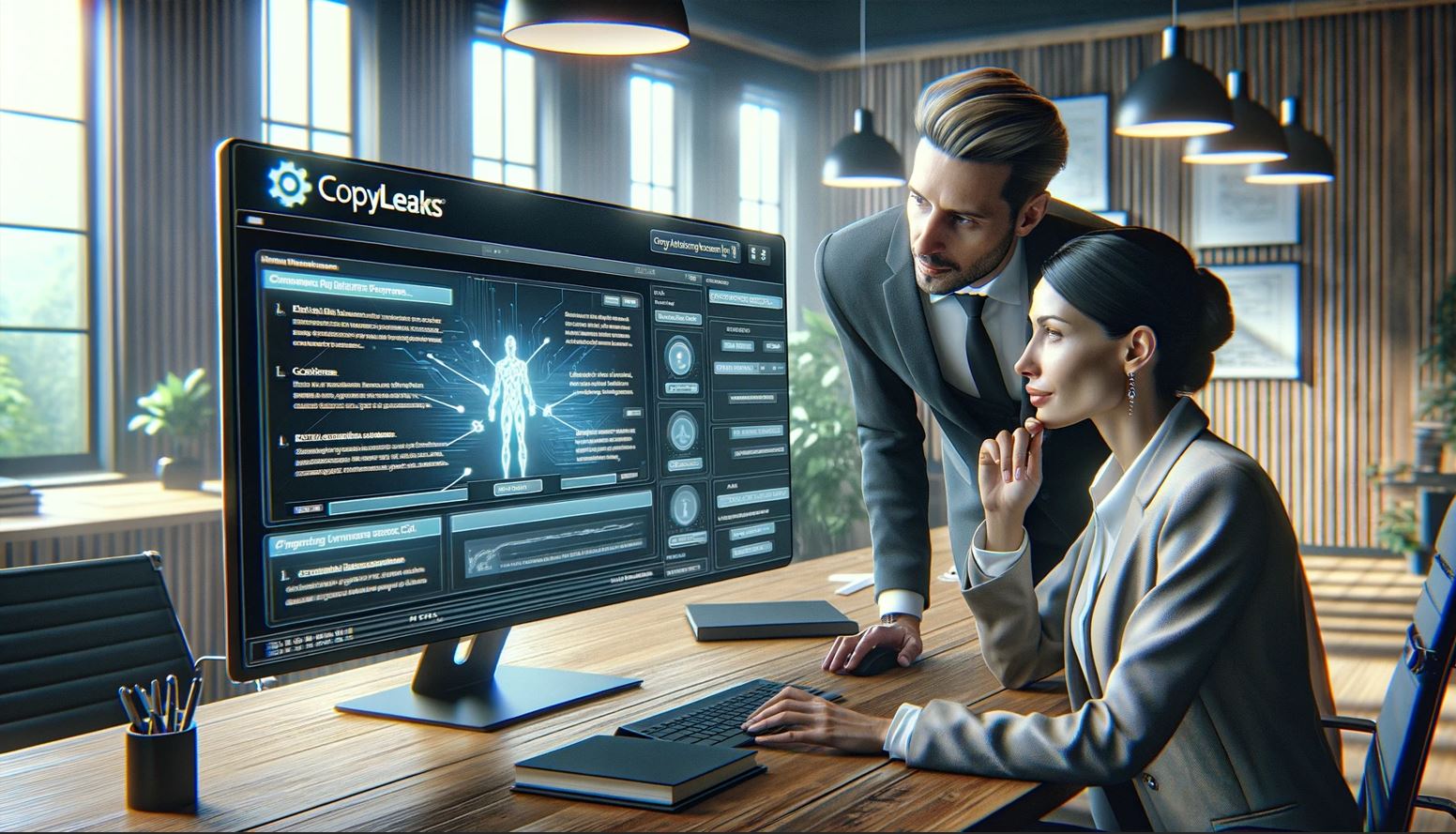
Reputation Damage
Reputation damage can hit like a ton of bricks. Imagine trusting Copyleaks to tell you what’s original and what’s not. Then, boom! You find out it messed up. It said something was fine when it wasn’t.
People might start thinking you’re not careful with your work or that you copy others. That’s bad news.
Now let’s say you run a school or business, right? If Copyleaks gets it wrong, people could question your commitment to truth and originality. They may not want to study at your school or buy what you’re selling anymore.
Ouch! Moving on beyond trust issues, there are legal risks too.
Legal Risks
Imagine you’re using Copyleaks to check if someone’s work is original. You think it’s good, but what if it’s wrong? If Copyleaks says something is okay when it’s not, big trouble can happen.
Someone might sue you for copyright infringement because they think you stole their words or ideas. That means going to court and spending lots of money on lawyers.
Now, let’s say you’re a teacher checking student papers with Copyleaks. You tell a student they copied stuff, but actually, Copyleaks made a mistake—it was all the student’s own words! This could lead to unfair grades and angry parents knocking on your door.
Problems like these show why we must make sure AI detection tools like Copyleaks are very accurate before we trust them too much.
Content Quality Issues
Moving on from legal risks, let’s talk about content quality issues. If Copyleaks isn’t doing its job right, it could say that good stuff is bad or miss the bad stuff pretending to be good.
Think of a teacher who can’t spot when a smart aleck copies an essay off the internet – not cool, right? Poor detection means everyone wastes time and brains on fixing what isn’t broken or missing the tricks in a sneaky copy-paste job.
Now imagine if you’re running a big project and Copyleaks gives you the thumbs up, but oops – there’s copied text all over your shiny new report. You’ve got egg on your face because this tool missed some duplicate content.
Plus, people might start thinking you can’t tell original from copied, which is like saying you can’t tell cats from dogs!
That’s how important accurate AI content detection is since it keeps things real and saves everyone from looking silly.
Resource Wastage
Using Copyleaks that isn’t accurate can lead to wasting resources. Think about it – if you’re trying too hard to find AI-generated text that isn’t there, you’re using up time and money.
Plus, if your trusty tool tells you something’s original when it’s not, well. that could mean redoing a bunch of work, right?
Those hours spent chasing false alarms could be put into creating cool stuff or checking real issues! Plus, if your trusty tool tells you something’s original when it’s not, well. that could mean redoing a bunch of work, right?
Now imagine everyone in your team doing the same thing over and over because they got the wrong info. Not great for anyone’s day.
It gets worse when people start losing faith in what the tool is saying. You might end up double-checking everything manually anyway—so why bother with an unreliable detector? Imagine pouring water into a bucket full of holes—you just don’t get anywhere.
We need tools we can count on to make sure our content is truly ours and keep things running smoothly without any hiccups!
Impact On Competitive Edge And Operational Efficiency
Wasting resources is just one part of the problem. A tool like Copyleaks that doesn’t work right can also hurt your business in a big way. If it misses copied stuff, competitors might get ahead by using sneaky tricks, and that’s not fair.
They could pass off stolen ideas as their own, winning customers and deals. Your team might spend too much time checking work twice or fixing problems when Copyleaks messes up. This means they’re not doing other important tasks that help the company grow.
Getting things wrong with AI content detection throws a wrench in the gears of your operation. Think about how smooth everything runs when you trust your tools to do their job – that’s what should happen! But if Copyleaks lets some copycat texts slip through, suddenly there’s chaos.
Everyone scrambles to figure out what went wrong, and before you know it, deadlines are missed and clients aren’t happy. It’s kind of like trying to win a race with flat tires – really slows you down!
Copyleaks Reviews: Fact Or Fiction?
Alright, let’s tackle the elephant in the room – are all those Copyleaks reviews we’ve stumbled upon as real as a unicorn sighting, or do they actually tell it like it is?
You’ve heard the raves and maybe some grumbles, but I’m here to sift through what’s hype and what’s legit.
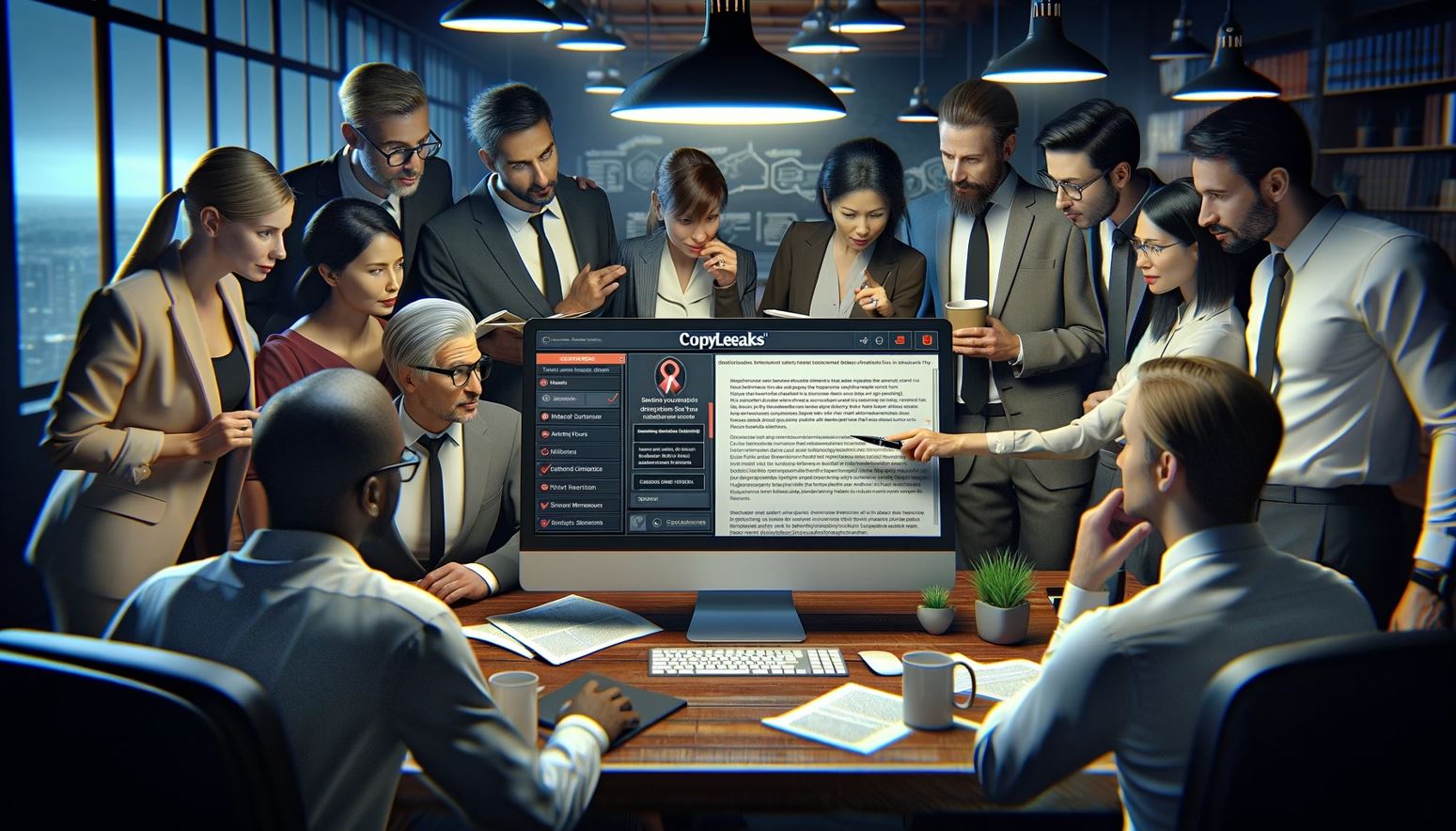
Understanding Copyleaks
So, Copyleaks is this tool that checks if writing is original or not. Imagine a detective for words. What it does is scan text and see if those words show up somewhere else on the internet or in its database.
Think of it as having super-vision for spotting copies. This feature comes in handy, especially when someone wants to make sure their work is totally unique.
Now let’s talk about how Copyleaks digs into documents to find out what’s authentic and what’s not. It uses some fancy tech magic—algorithms and machine learning—to sniff out any parts of text that might have been taken from other places without giving credit.
This means teachers, writers, and all sorts of people can check whether the content handed to them hasn’t been copied from another spot on the big web—or even from some sneaky source trying to pretend it’s new when it’s actually old news!
Review Process
Alright, let’s get into how users rate Copyleaks. They go online and share their experiences with this tool. They talk about how well it finds copied text or spots AI-written stuff.
And boy, do these reviews vary! Some people say it’s spot on—catches everything from sneaky student essays to that blog post a little too inspired by someone else’s work. Others aren’t so thrilled. They report missing marks or getting false alarms.
Now, peeking at the review process is like looking under the hood of a car—we see what makes it tick. Users run their content through Copyleaks and wait for the magic to happen. The system checks each word, scans for similarities, and goes deep to uncover any AI fingerprints hidden in the text.
This moment can feel like an eternity if you’re sweating over potential plagiarism!
Results Of Copyleaks’ AI Content Detection
Copyleaks has jumped into the spotlight with its promise to spot AI-written text. Let’s look into what the tests show about how well it really works.
- A bunch of studies took Copyleaks for a spin to see if it can tell human writing from AI stuff. What they found is kind of a mixed bag, but let’s break it down.
- This tool shines when the job is to find copy-paste cheats in homework or articles. It’s all about matching words and phrases to its huge database.
- When pitted against other smart tools like Turnitin, Copyleaks held its own. It’s good at spotting where content came from and if it’s been changed a bit.
- But here’s the twist – detecting AI-generated writing isn’t as easy-peasy. Sometimes, Copyleaks gets tricked by smarty pants AI trying to sound like a person.
- The misclassification rate isn’t zero – that means Copyleaks sometimes says something is AI when it isn’t or misses the mark altogether.
- Studies have thrown tough challenges at it, like essay prompt-style stuff that mixes human and computer smarts. Sometimes Copyleaks nails it but other times, not so much.
- Accuracy in these tests varied like crazy—some days good, some days just okay. You could say it’s reliable but not perfect.
- In terms of content authenticity verification, this tool can give you peace of mind …. most of the time. Think of it as an extra pair of eyes rather than your only line of defense.
- Tossing creativity into the mix makes things harder for Copyleaks. The more unique and out-there your writing is, the trickier it gets for any software to judge if you or a bot wrote it.
Copyleaks Delves Deep Into AI Content Detection
So there you have it, an insightful look into the world of Copyleaks and its place in the grand scheme of AI content detection—turns out that keeping it honest in the digital age is no small feat, but someone’s gotta do it.
If you’re curious about all things plagiarism and originality (and let’s be real—who isn’t?), stick around for more insights that just might make your head spin—in the best way possible!
Overall Accuracy Of Copyleaks
Copyleaks is pretty spot on when it comes to figuring out if the text is made by a person or AI. It’s kind of like a super sleuth for words, sniffing out the real from the fake. They use cool tech to check writing and tell if it’s original or not.
This matters a lot because schools, writers, and businesses want their stuff to be one of a kind.
Sure, no tool’s perfect, and Copyleaks might miss the mark sometimes—it could say something’s copied when it isn’t (that’s called a “false positive“) or give the green light to something that’s actually copied (yep, that’s a “false negative”).
But most people who’ve put Copyleaks through its paces find it reliable. That means you can trust this tool quite a bit to keep content authentic and help guard against sneaky copycats!
Comparison To Other Detection Tools
When stacking up Copyleaks against its high-tech cousins in the world of AI-generated content detection tools, the differences can range from subtle to “whoa, didn’t see that coming”.
So, let’s take a look at an old-school comparison chart. Consider this is the cheat sheet you didn’t know you needed.
| Feature | Copyleaks | Tool A | Tool B |
|---|---|---|---|
| Accuracy of Detection | High | Moderate | Varies |
| AI Content Identification | Advanced algorithms | Basic patterns | Machine learning models |
| Ease of Use | User-friendly interface | Steep learning curve | Intuitive design |
| Database Size | Extensive | Limited | Comprehensive |
| Speed | Quick | Slow | Fast |
| Language Support | Multiple languages | English primarily | Several languages |
| Price | Competitive | Costly | Affordable |
| Customer Support | Responsive and helpful | Lacking | Good |
With a side-by-side glance, you’ve gotta admit, Copyleaks is looking pretty spiffy. Imagine comparing a high-end sports car with the reliability of a sedan and the price tag of a compact.
You’re getting a whole lot of vroom for your buck! Sure, ‘Tool B’ might edge it out in the speed department, and ‘Tool A’ could be your go-to if you’re up for a techy challenge, but for sheer dependability and the ability to understand more than “Hello” and “Goodbye” in a handful of tongues, Copyleaks takes the cake.
Now, don’t get me wrong. Your choice of AI detection tools should fit like a glove – snugly, comfortably, and without cutting off the circulation to your common sense.
We love a good bargain but remember, sometimes a few extra dollars can save you a headache down the line.
It’s all about finding that sweet spot where quality meets your wallet, and that’s not always where you might expect it to be.
Importance Of Continual Vigilance In Detecting AI-Generated Content.
So, Copyleaks holds its own against other tools, right? But let’s not get too comfy. We gotta keep our eyes peeled for AI-generated content all the time. See, this stuff is getting smarter by the minute.
If we blink, it could slip past us. And nobody wants to deal with a sneaky bot’s homework passing as a kid genius’s summer essay.
Keeping track of AI content isn’t just about spotting fakes. It also keeps things fair and square. Imagine someone using an AI to crank out articles faster than you can say “originality.” That wouldn’t be playing nice in the sandbox now, would it?
It’s about keeping the game honest – making sure everyone writes their own stories and ideas stay fresh and real.
Plus, we’ve got to make sure no one pulls a fast one on us!
FAQs
1. Is Copyleaks good at finding copied text?
Yes, Copyleaks is pretty sharp at sniffing out copied stuff in your papers.
2. Can Copyleaks check my essay for any sneaky plagiarism?
For sure! It’ll scan your essay and show if someone else’s words are playing hide-and-seek in there.
3. Will Copyleaks miss anything when it checks my work?
Not much slips past Copyleaks—it catches almost everything, but remember, nobody’s perfect!
4. Does it take long for Copyleaks to do its thing?
Nope, it’s quick as a bunny—just give it your paper and watch the magic happen.
5. Can I trust what Copyleaks tells me about my writing?
You bet! It’s as if you have a smart friend who always tells you the truth about your work.
Meet our resident tech wizard, Steve the AI Guy. Now, before you get any wild ideas, let’s clear up one thing – he’s 100% human! I mean, he’s got the work history to prove it. He spent a decade diving into the deep end of the tech industry doing business intelligence work, splashing around with two of the world’s largest business consulting companies, Deloitte and Ernst & Young. Learn More





